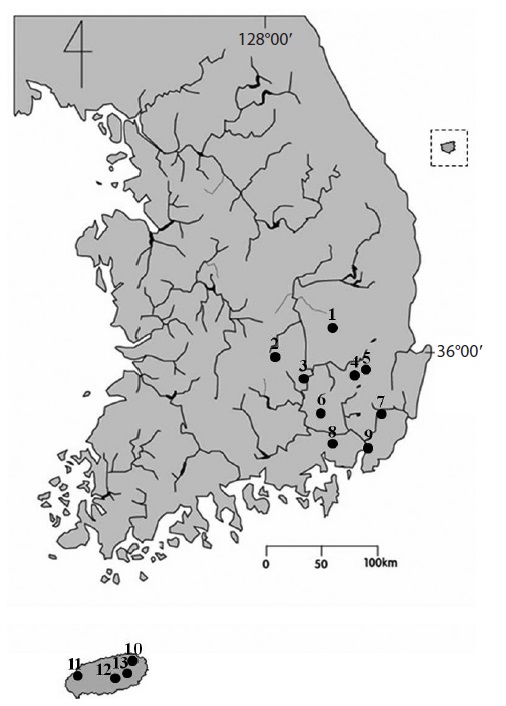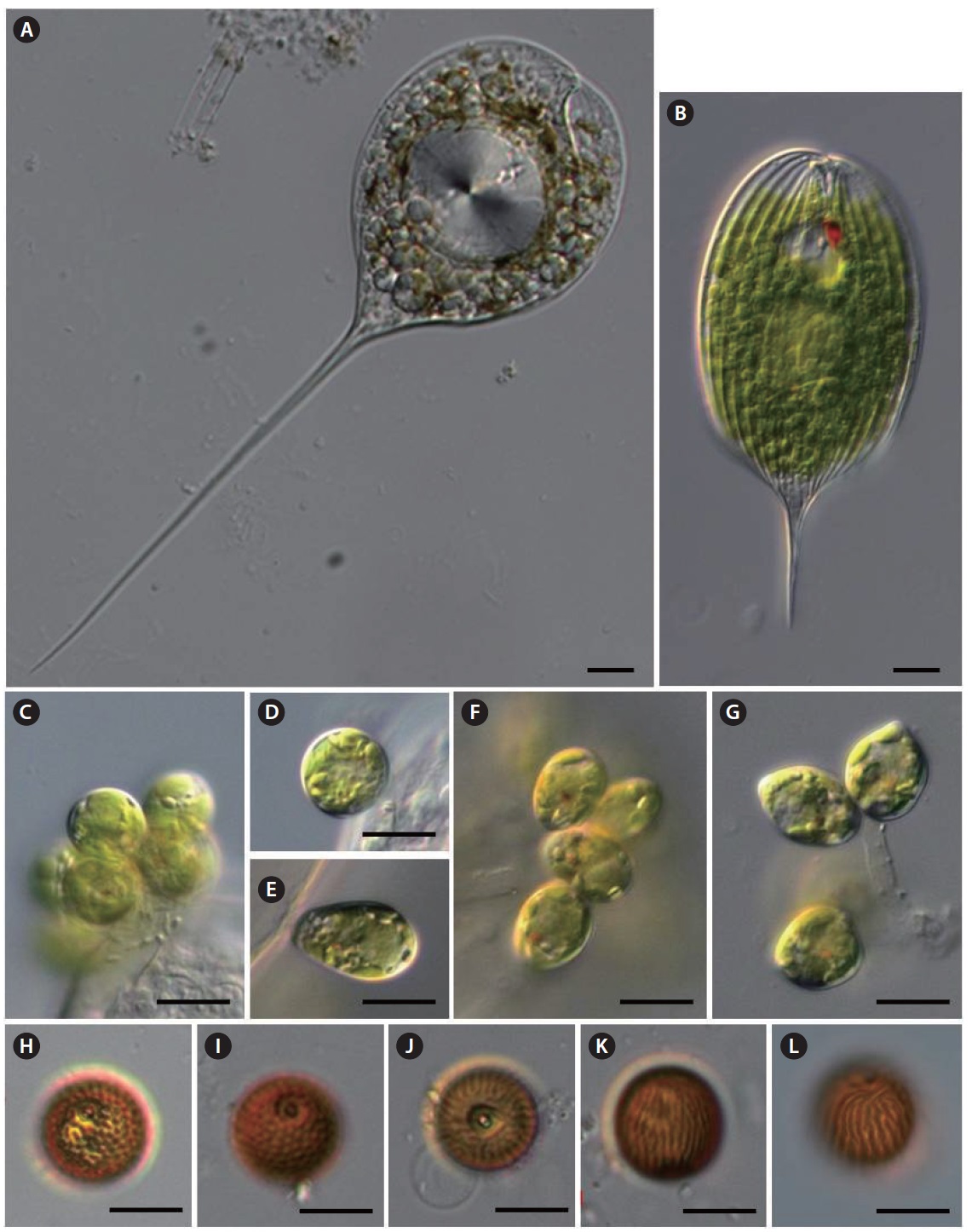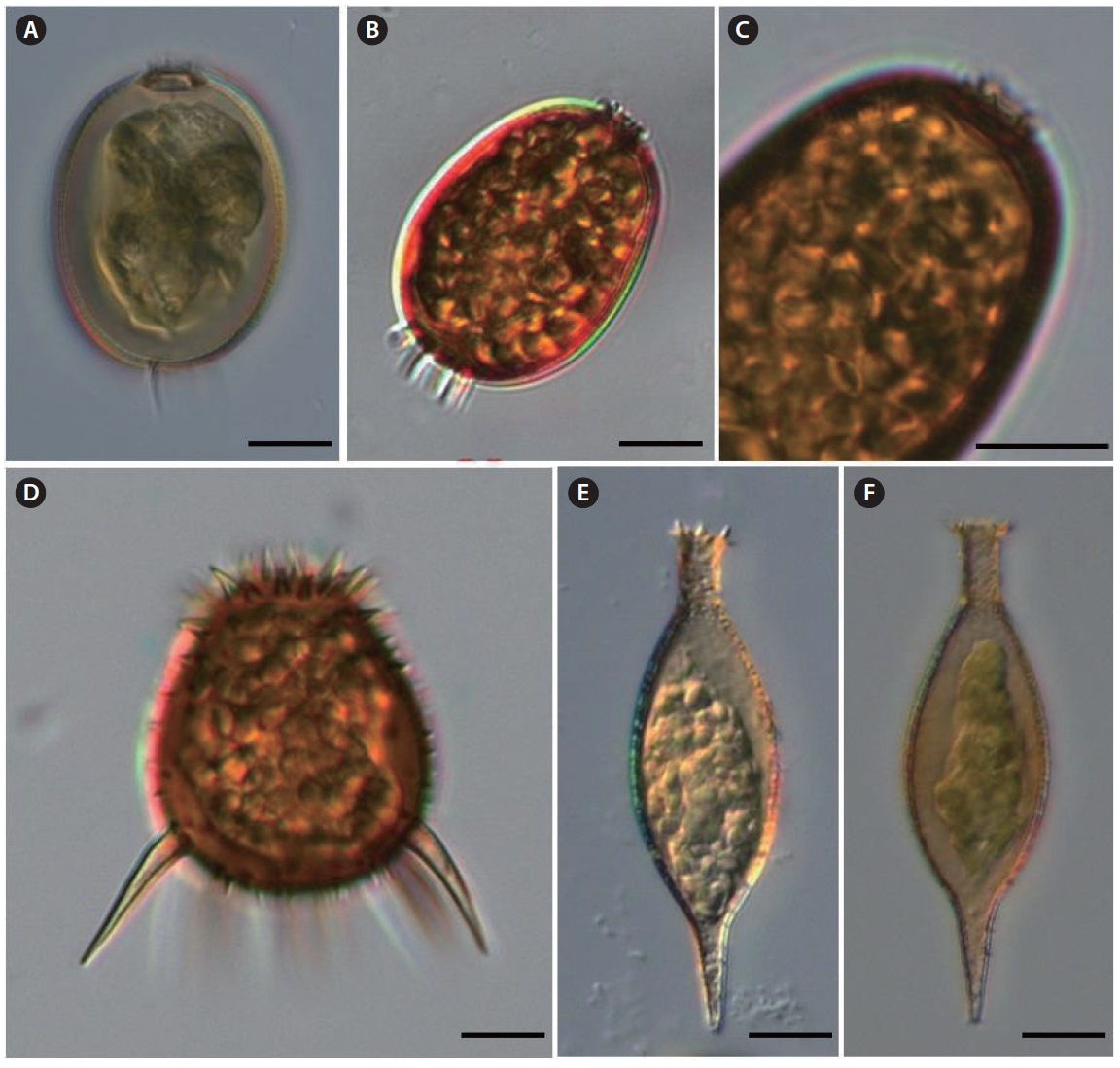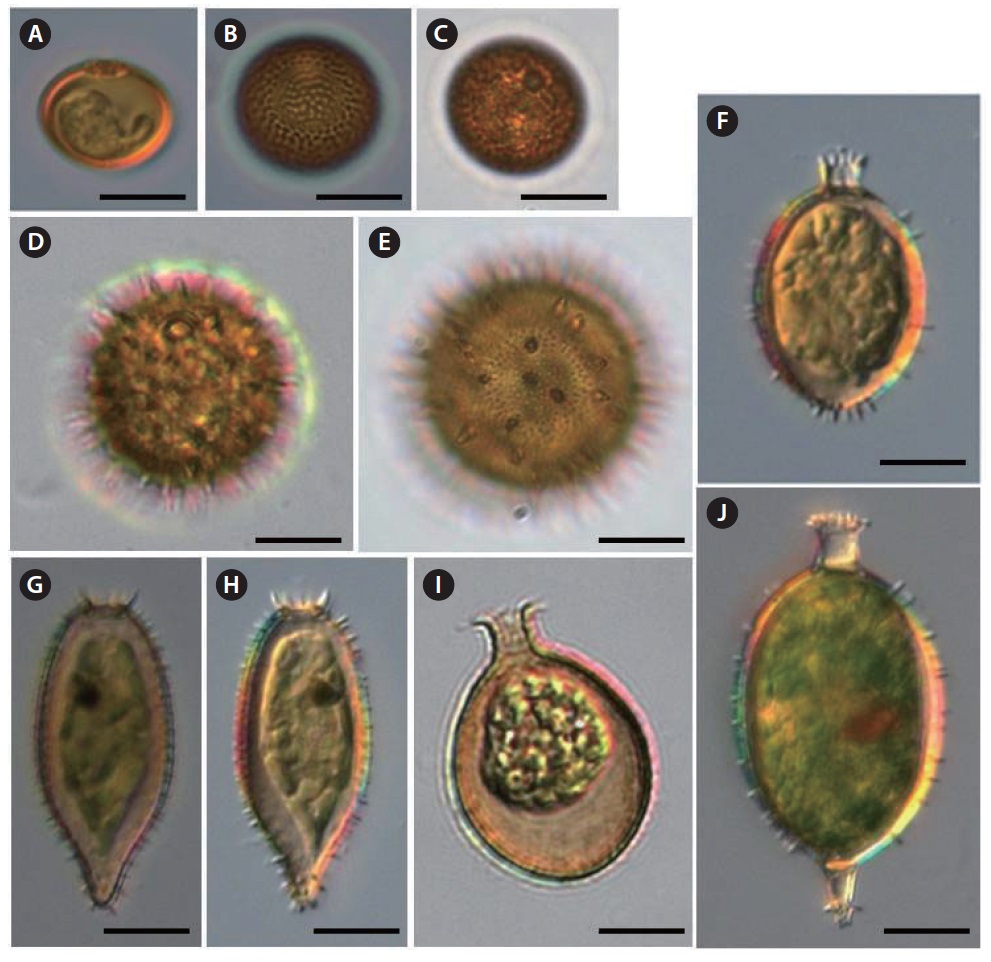



Since Kawamura (1918) reported a species of
The importance of biological diversity has been emphasized, and the discovery of indigenous species for securing the sovereignty over biological resources is recognized as an urgent national task. Therefore, freshwater algae investigations in uninvestigated regions in Korea including unusual environments (e.g., highland moorlands, mountain sphagnum bogs or wetlands and craters) are required immediately.
More than 500 samples were collected from various water bodies throughout the country and were investigated to establish freshwater algal flora in Korea. This study reports 18 species of Euglenophytes for the first time in Korea.
Over 500 samples were collected from various types of wetland habitats ranging from eutrophic reservoirs and diverse swamps to oligotrophic and acidic mountainous wetlands, sphagnum bogs, orum (very small and shallow caldera lakes) from 2009 to 2013 (Fig. 1). The samples were obtained by plankton net (mesh size 25 μm), spoid or by squeezing submerged macrophytes. Living material was examined immediately. After the initial examination, all materials were fixed with 5% formalin for permanent preservation and detail identification. Microscopic examinations were made at ×200 to ×1,000 magnification with an Axio Imager microsope (A2; Carl Zeiss, Oberkochen, Germany), and photographs were taken with an AxioCam
[Table 1.] Sampling date and environmental factors of the sampling sites
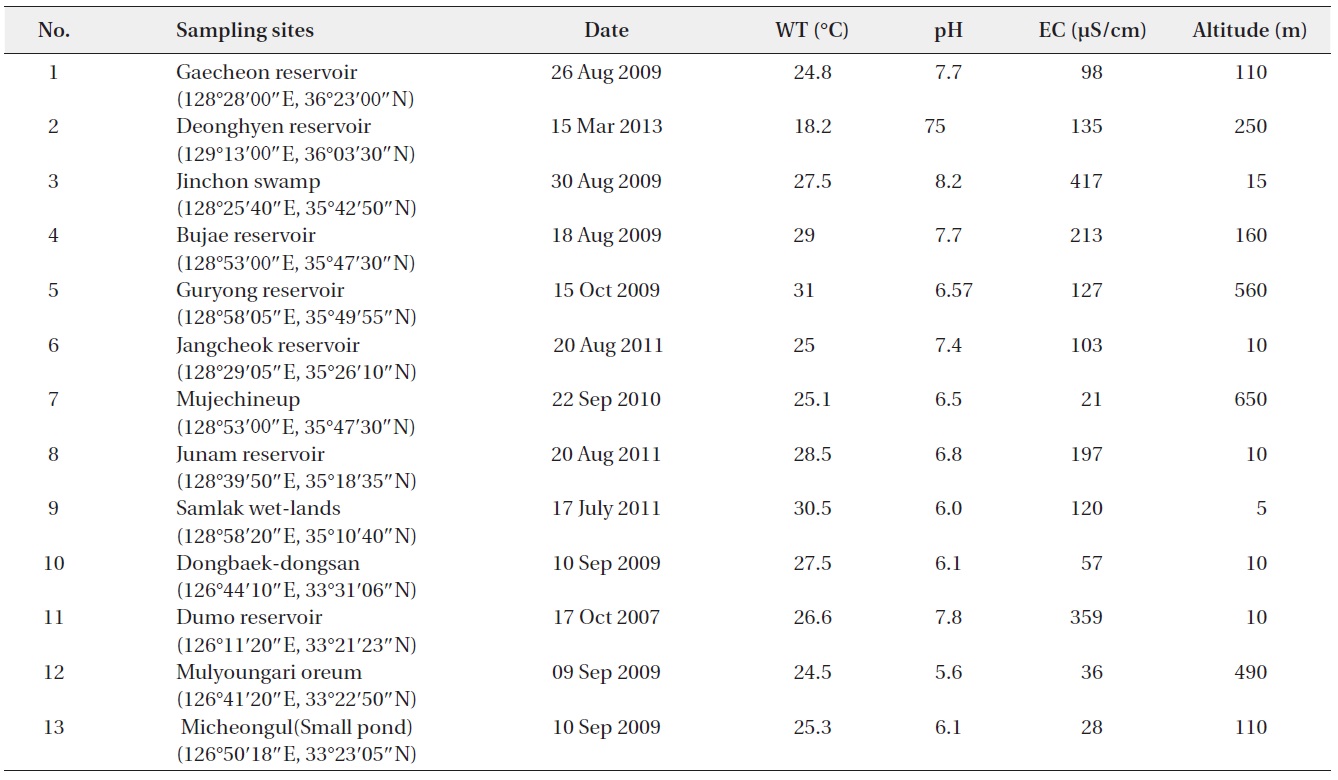
Sampling date and environmental factors of the sampling sites
HRC camera (Carl Zeiss). Water temperature, pH, and conductivity were measured in the field with a HI8314 membrane pH meter (Hanna instruments, Smithfield, RI, USA) and a HI9835 EC meter (Hanna instruments). 18 species of Euglenophyta, which have not previously been recorded from Korea, are described and illustrated with photographs. The materials were deposited at the National Institute of Biological Resources (NIBR) and Department of Biology, Kyungpook National University.
Colacium mucronatum Bourrelly et Chadefaud (
References: Huber-Pestalozzi 1955, p 134, pl. 25, fig. 115a–c; Tell and Conforti 1986, p 182, fig. 428 a–c; Yamagishi and Akiyama 1989a, p 12.
Description: Cells 12–13 µm in diameter, 16–18 µm long, ovoid or fusiform, rounded at anterior end and with a papilla-like small projection at the posterior end,
attached by dichotomously branched mucilaginous gelatinous stalks; periplast thin and spiral, chloroplast discshaped, 6–8 in number, each with an inner pyrenoid; usually growing as sessile colonies on freshwater zooplankton such as
This species is probably cosmopolitan, and rarely occurs in reservoirs, ponds, ditch and swamps where usually attached to Crustacea, copepods and rotifers. Occurrence: Collected at Guryong reservoir.
Occurrence: Collected at Guryong reservoir.
Colacium simplex Ehuber-Pestalozzi (
References: Huber-Pestalozzi 1955, p 123, pl. 23, fig. 107a–d; Shi 1999, p 90, pl. 31, figs. 6–8.
Description: Cells 12–13 µm in diameter, ovoid or subspherical, solitary or colony of two to several cells attached to substratum by a pillow-like mucilaginous cushion; usually growing as sessile colonies on freshwater zooplankton such as
This species reported in Romania, Turkey and China and usually occurs in reservoirs, ponds, ditches and swamps where usually attached to Crustaceae, copepods and rotifers.
Occurrence: Collected at Guryong reservoir.
Colacium vesiculosum Ehrenberg (
References: Huber-Pestalozzi 1955, p 127, pl. 24, fig. 112a–h; Tell and Conforti 1986, p 183, fig. 430a–c; Yamagishi and Akiyama 1989a, p 13; John et al. 2011, p 184, pl. 54, fig. T–W.
Description: Cells 12–13 µm in diameter, 18–20 µm long, ovoid or fusiform with rounded posterior end, solitary or forming dendroid colonies of two, four or eight cells attached by a short, unbranched mucilaginous stalk or dichotomously branched gelatinous stalks; usually growing as sessile colonies on freshwater zooplankton such as Cladocera or Coprpoda.
This species is distributed worldwide and usually occurs in reservoirs, ponds, ditches and swamps where it is usually attached to Crustaceae, copepods and rotifers.
Occurrence: Collected at Guryong reservoir.
Phacus longicauda var. major Swirenko (
References: Huber-Pestalozzi 1955, p 223, pl. 49, fig. 302; Yamagishi and Akiyama 1989b, p 60; Shi 1999, p 233, pl. 71, fig. 2.
Description: Cells broadly ovoid to ellipsoid, nearly symmetrical, anterior end broadly rounded, shallowly bilobed; posterior end narrowed and tapering into a cauda; caudae long, nearly straight or slightly curved; lateral margins broadly rounded; paramylon bodies usually a single, large ring-like or circular plate; periplasts longitudinally roughly striated; cell length 170–185 µm with cauda, 70–75 µm without cauda, diameter 55–65 µm. This species distributed worldwide and usually occurs in reservoirs, ponds and swamps where the freshwater is mineralized or has high humic content.
Occurrence: Collected at Samlak wet-lands, Guryong reservoir and Jangcheok reservoir.
Phacus ranula Pochmann (
References: Huber-Pestalozzi 1955, p 227, pl. 52, fig. 313a–e; Yamagishi and Akiyama 1985, p 65; Shi 1999, p 234, pl. 72, fig. 5.
Description: Cells 45–55 µm in diameter, 75–85 µm long without cauda, caudae 25–35 µm, broadly fusiform to ellipsoid, anterior end slightly narrowed and rounded, posterior end narrowed and tapering into a cauda; caudae about one third of cell length, straight, sharply pointed, sometimes recurved at end; lateral margins broadly rounded; periplasts longitudinally striated; paramylon bodies two to several, circular plate-like.
This species distributed worldwide and usually occurs in reservoirs, ponds and swamps where the freshwater is mineralized or has high humic content.
Occurrence: Collected at Junam reservoir, Samlak wetlands and Jangcheok reservoir.
Trachelomonas armata var. longa Deflandre 1926 (
References: Huber-Pestalozzi 1955, p 310, pl. 67, fig. 591; Yamagishi and Akiyama 1995a, p 71.
Description: Lorica 29–31 µm in diameter, 40–43 µm long; posterior spines 10–15 µm long, long broad-ovoid; anterior and posterior ends broadly rounded; lateral sides nearly straight and parallei; flagellum apertures without a collar; wall densely punctuate, roughly beset with short spines at the anterior end and stout long spines at the posterior end.
This species is distributed worldwide and commonly occurs in mesotrophic to eutrophic reservoirs, ponds and swamps.
Occurrence: Collected at Gaecheon reservoir, Mulyoungari, Guryong reservoir, Samlak wet-lands and Jangcheok reservoir.
Trachelomonas armata var. ovata D.O. Swirenko (
References: Huber-Pestalozzi 1955, p 310, pl. 68, fig. 593; Yamagishi and Akiyama 1987a, p 89.
Description: Lorica 30–33 µm in diameter, 40–46 µm long; posterior spines 15–25 µm long, broadly ovoid; anterior end slightly truncate, posterior end broadly rounded; lateral sides swelled; flagellum apertures with or without a low collar but surrounded by a circle of short spines; anterior parts of wall beset with many short, stout spines and posterior parts with long, stout spines.
This species is distributed worldwide and commonly
ococcurs in mesotrophic to eutrophic reservoirs, ponds and swamps.
Occurrence: Collected at small pond near the Micheongul, Mulyoungari and Guryong reservoir.
Trachelomonas armata var. rangpurens Islam & Muniruzzaman (
Reference: Yamagishi and Akiyama 1995a, p 72.
Description: Lorica 28–30 µm in diameter, 34–37 µm long, posterior spines 6–8 µm long, broad-ellipsoid to ovoid; anterior and posterior ends rounded; lateral sides broadly swelled; flagellum apertures without a clear collar, but encircled by 4–6 short, curved stout spines; wall finely punctate, with 4-8 long, curved, stout spines at the posterior portion.
This species is distributed worldwide and usually occurs in mesotrophic to eutrophic reservoirs, ponds and swamps.
Occurrence: Collected at Guryong reservoir.
Trachelomonas arnoldina var. decurtata Skvortzov (
References: Huber-Pestalozzi 1969, p 332, pl. 71, fig. 686; Yamagishi and Akiyama 1987b, p 92.
Description: Lorica 24–26 µm in diameter, 29–31 µm long without the collar; collar 3.4–4.5 µm wide, 4–5 µm long, broad-ovoid; anterior ends slight narrowly rounded, posterior end broadly rounded, lateral sides broadly rounded; flagellum apertures with a long, cylindric collar having a irregular or serrated and flared mouth; wall densely punctate.
This species is distributed worldwide and usually ococcurs curs in mesotrophic to eutrophic reservoirs, ponds and swamps.
Occurrence: Collected at Dumo reservoir.
Trachelomonas baikovii Skvortzov (
References: Huber-Pestalozzi 1955, p 357, pl. 76, fig. 773; Shi 1999, p 148, pl. 42, fig. 10.
Description: Lorica 48–52 µm long, 23–25 µm in diameter, collar 4–5 µm long, cauda 7–8 µm long, ellipsoid to fusiform; anterior end gradually narrowed into a cylindrical collar; posterior end conically narrowed into a conical cauda with several short spines at the end; flagellum apertures with a cylindric collar having a crown of some short spines around the mouth; wall covered with conical short spines. This species reported in Europe and China.
Occurrence: Collected somewhat abundantly at mesotrophic Samlak wetl-ands.
Trachelomonas bernardii Woloszynska (
References: Huber-Pestalozzi 1955, p 270, pl. 59, fig. 432; Yamagishi and Akiyama 1995a, p 74; Shi 1999, p 108, pl. 34, fig. 5.
Description: Lorica 11–12 µm long, 15–16 µm in diameter, compressed globose; transversely ellipsoid with rounded sides in lateral view, circular in vertical view; flagellum apertures without a collar; wall smooth.
This species is distributed worldwide and usually occurs in mesotrophic to eutrophic reservoirs, ponds and swamps.
Occurrence: Collected at Gaecheon reservoir, Guryong reservoir, Junam reservoir and Samlak wet-lands.
Trachelomonas globularia var. gigas Drezepolski (
References: Huber-Pestalozzi 1955, p 268, pl. 57, fig. 379; Yamagishi and Akiyama 1995a, p 72.
Description: Lorica globose, 27–30 µm in diameter without spines, spines 4–5 µm long; flagellum apertures without a collar; wall covered with micro-puncta and long, stout, sharp conical spines. Cells more large than in the nominate variety.
This species is distributed worldwide and usually occurs in mesotrophic to eutrophic reservoirs, ponds and swamps.
Occurrence: Collected at Guryong reservoir, Samlak wet-lands and Junam reservoir.
Trachelomonas helvetica var. cucurbita (Skvortzov) Huber- Pestalozzi (
Reference: Huber-Pestalozzi 1955, p 356, pl. 76, fig. 771.
Description: Lorica 35–37 µm long, 13–15 µm in diameter, ellipsoidal or ovoid, anterior end rounded, posterior end tapered into a conical short cauda; flagellum apertures wide, without a collar, but encircled by 6-8 short spines; wall covered with conical short spines. The variety differs from the nominal by a higher length/breadth ratio and with narrower width.
This species has been reported only in Europe and rarely occurs in mesotrophic to eutrophic reservoirs, ponds and swamps.
Occurrence: Collected at Samlak wet-lands.
Trachelomonas mirabilis var. affinis Skvortzov (
References: Huber-Pestalozzi 1955, p 312, pl. 68, fig. 601; Yamagishi and Akiyama 1987b, p 92; Shi 1999, p 141, pl. 41, fig. 3.
Description: Lorica 20–22 µm in diameter, 31–33 µm long with collar, collar 3–5 µm long, broadly fusiform, anterior and posterior ends narrowly rounded, lateral sides swelled; flagellum apertures with a cylindric collar having a circle of stout spines at mouth; wall covered with many short, stout spines.
This species is distributed worldwide and usually occurs in mesotrophic to eutrophic reservoirs, ponds and swamps.
Occurrence: Collected at Guryong reservoir, Jangcheok reservoir, Junam reservoir and Samlak wet-lands.
Trachelomonas nadsonii Skvortzov (
Reference: Huber-Pestalozzi 1955, p 358, pl. 76, fig. 774.
Description: Lorica 16–18 µm in diameter, 55–60 µm long with collar and caudal projection, collar 4–5 µm wide, 7–9 µm long; posterior cauda 10–12 µm long, narrow-ellipsoid to fusiform; anterior end conically narrowed into a cylindrical collar; posterior end conically narrowed into a conical cauda; flagellum apertures with a long, cylindrical collar having several short spines around the mouth; wall punctuate, covered with sparsely scattered short spines.
This species has been reported in Europe and China and rarely occurs in mesotrophic to eutrophic reservoirs, ponds and swamps.
Occurrence: Collected at Samlak wet-lands.
Trachelomonas sculpta Balech (
References: Huber-Pestalozzi 1955, p 263, pl. 58, fig. 400B; Yamagishi and Akiyama 1995b, p 94.
Description: Lorica spherical, 17–20 µm in diameter; flagellum apertures (2–2.5 µm in diameter) surrounded by an annular thickening; wall reddish-brown, ornamented with polygonal depressions, closely distributed.
This species is distributed worldwide and usually occurs in mesotrophic to eutrophic reservoirs, ponds and swamps.
Occurrence: Collected at Gaecheon reservoir, Guryong reservoir, Jangcheok reservoir, Junam reservoir and Samlak wet-lands.
Trachelomonas stokesiana Palmer (
References: Huber-Pestalozzi 1955, 264, pl. 58, fig. 407a–c; Yamagishi and Akiyama 1989a, p 95; Shi 1999, p 105, pl. 33, fig. 9.
Description: Lorica 17–18 µm long, 15–16 µm in diameter, globose to subglobose, slightly longer than the diameter; flagellum apertures with a short cylindrical collar; collars bluntly conical seated in a shallow circular depression; wall ornamented with conspicuous, distinct, occasionally anastomosing, continuous ridge, obliquely longitudinal on the side, nearly spiral at the ends.
This species is distributed worldwide and usually occurs in mesotrophic to eutrophic reservoirs, ponds and swamps.
Occurrence: Collected at Gaecheon reservoir, Guryong reservoir, Jangcheok reservoir, Junam reservoir and Samlak wet-lands.
Trachelomonas verrucosa var. irregularis Deflandre (
References: Huber-Pestalozzi 1955, p 263, pl. 58, fig. 400B; John et al. 2011, p 226, pl. 57, figs. N, O.
Description: Lorica spherical, diameter 12.5–14 µm; flagellum apertures without a collar, surrounded by an annular thickening; wall reddish-brown, ornamented with close, irregular small warts or granules.
This species has been reported in Europe and North America and commonly occurs in mesotrophic to eutrophic reservoirs, ponds and swamps.
Occurrence: Collected at Dumo reservoir, Guryong reservoir, Junam reservoir and Samlak wet-lands.
In this study, 18 species of Euglenophyceae were newly added to the Korean freshwater algal flora.
